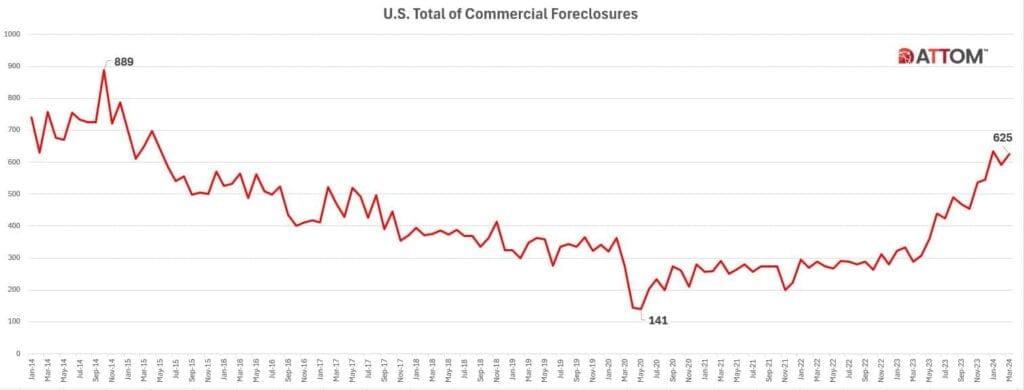The commercial real estate market is facing headwinds as interest rates continue their upward climb. With the Federal Reserve taking aggressive action to combat inflation, borrowing costs for commercial properties have risen substantially, leading to concerns about the health of the sector. Recent data from ATTOM, a leading real estate data firm, sheds light on how these macroeconomic factors are playing out in the market.
Commercial Foreclosures on the Rise
One of the most striking indicators of the challenges facing commercial real estate is the sharp uptick in foreclosure activity. According to ATTOM’s latest monthly report on U.S. commercial foreclosures, default filings have been steadily increasing over the past few years.
In May 2020, at the height of the pandemic-induced economic downturn, there were just 141 commercial properties with foreclosure filings nationwide. Fast forward to March 2024, and that figure has skyrocketed to 625 properties – a staggering 117% increase year-over-year and a 343% jump from the 2020 low.

This troubling trend suggests that more and more commercial property owners are struggling to keep up with their mortgage payments as interest rates rise and refinancing becomes more difficult and expensive.
A Closer Look at State-Level Data
Drilling down to the state level reveals that the foreclosure surge is widespread, with some of the nation’s largest commercial real estate markets seeing the biggest spikes in distress.
California, which has the highest number of commercial properties in the country, also had the most foreclosure filings in March 2024 with 187. While this was an 8% decrease from the previous month, it represents a staggering 405% increase compared to a year ago. The state began experiencing a notable rise in commercial foreclosures starting in November 2023 when it surpassed 100 filings and continued to see escalating distress in the following months.
Other major commercial real estate markets like New York, Florida, Texas, and New Jersey also saw significant increases in foreclosure activity compared to both the previous month and year. In March 2024:
- New York had 61 commercial foreclosures, up 5% from February and 65% from March 2023.
- Florida saw a 30% monthly increase and a 107% annual increase in filings.
- Texas experienced a 31% jump from the previous month and a 129% surge year-over-year.
- New Jersey had a 31% monthly increase and a 133% spike from March 2023.
These numbers paint a picture of a commercial real estate market under increasing stress as property owners grapple with the impact of higher interest rates on their bottom lines.
Interest Rates Squeeze Property Owners
To understand why rising interest rates are such a significant headwind for commercial real estate, it’s important to consider how the market operates.
The Role of Leverage
Most commercial properties are purchased using a combination of equity from the buyer and debt financing in the form of mortgages. This leverage allows investors to acquire properties that would otherwise be out of reach and can amplify returns when the market is strong.
However, leverage is a double-edged sword. When interest rates rise, as they have been doing aggressively since early 2022, the cost of servicing this debt increases. Property owners who financed their acquisitions with adjustable-rate mortgages or who need to refinance maturing loans are particularly vulnerable.
Refinancing Challenges
In a rising rate environment, refinancing becomes more difficult and expensive. Lenders tighten their underwriting standards, requiring more equity from borrowers and offering less favorable terms. This can put property owners in a bind, especially if their property has lost value or their rental income has declined.
According to a recent survey by the National Association of Realtors, 31% of commercial real estate professionals reported that they had a deal fall through due to financing issues in the first quarter of 2024. This is up from just 7% who reported financing-related deal failures a year ago.
The Specter of Maturity Defaults
Perhaps the biggest risk facing the commercial real estate market in the coming years is the looming wave of loan maturities. Over the next three years, an estimated $1.4 trillion in commercial real estate loans are set to mature, according to data from Trepp.
Many of these loans originated during the low-interest rate environment of the past decade, when borrowing costs were at historic lows. As these loans come due, property owners will need to refinance at much higher rates, putting pressure on their cash flows and potentially pushing some into default.
This risk is particularly acute for properties that have seen their valuations decline due to the pandemic or other market factors. If a property is worth less than the outstanding loan balance, the owner may struggle to refinance or be forced to inject additional equity to get a new loan.

The Outlook for Commercial Real Estate
So what does the future hold for the commercial real estate market as interest rates continue to rise? While there are certainly challenges ahead, it’s important to remember that the sector is not monolithic and that some property types and markets may fare better than others.
Bright Spots Amidst the Uncertainty
Despite the overall headwinds facing the market, some segments of commercial real estate are showing resilience. Industrial properties, in particular, have been a bright spot, buoyed by strong demand from e-commerce companies and a shift towards onshoring of manufacturing.
According to CBRE, the national vacancy rate for industrial properties fell to an all-time low of 3.1% in the first quarter of 2024, down from 3.4% a year ago. Rents also continued to climb, up 9.1% year-over-year, as companies competed for scarce space.
Multifamily properties have also held up relatively well, as demand for rental housing remains strong in many markets. While rising rates have made it more expensive to finance apartment acquisitions and developments, the fundamentals of the sector remain healthy, with vacancy rates near historic lows and rents continuing to grow in most markets.
The Importance of Location and Property Type
As the market adjusts to higher interest rates, the performance of individual properties will increasingly depend on their location and property type. Properties in markets with strong economic fundamentals and limited new supply are likely to fare better than those in oversaturated or economically challenged areas.
Similarly, properties that cater to industries with strong growth prospects, such as life sciences and technology, may outperform those that are more exposed to struggling sectors like retail and hospitality.
The Need for Creative Solutions
For property owners facing refinancing challenges or potential defaults, creativity and flexibility will be key. Some may need to explore alternative financing options, such as mezzanine debt or preferred equity, to bridge the gap between their existing loan and the new financing they can secure.
Others may need to consider selling assets to shore up their balance sheets or partnering with investors who can provide additional capital. In some cases, lenders may be willing to offer loan modifications or extensions to help borrowers weather the storm.

Conclusion
The rise in interest rates is undoubtedly a significant challenge for the commercial real estate market, as evidenced by the sharp increase in foreclosure activity in recent months. However, it is important to remember that the sector has weathered previous cycles and emerged stronger on the other side.
While some properties and markets will undoubtedly struggle in the near term, others will find opportunities to adapt and thrive. Investors and property owners who are able to navigate the changing landscape with creativity, flexibility, and a focus on fundamentals will be best positioned to succeed in the years ahead.
As always, it will be critical to monitor market conditions closely and seek out expert guidance to make informed decisions in this rapidly evolving environment. With the right strategies and a long-term perspective, commercial real estate can continue to offer compelling opportunities for those who are prepared to meet the challenges of the moment.




